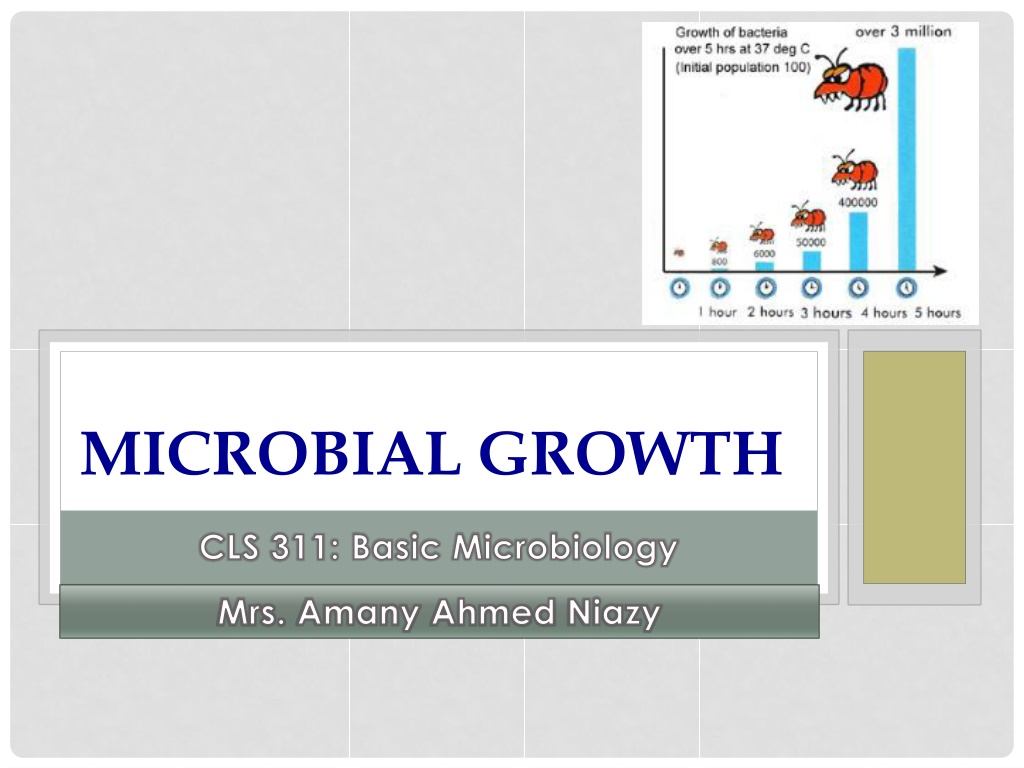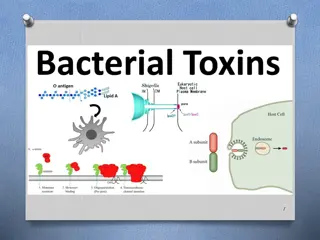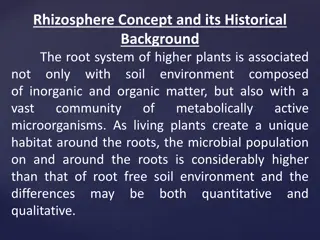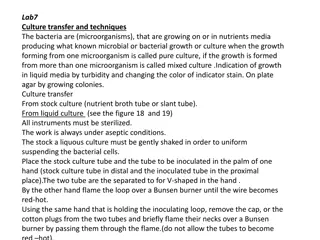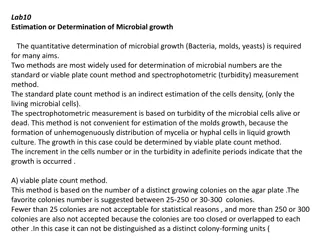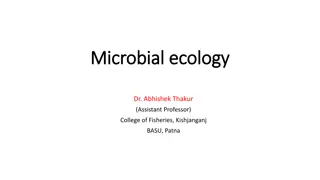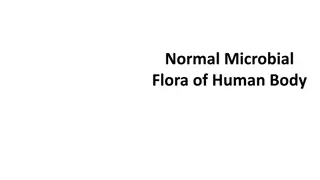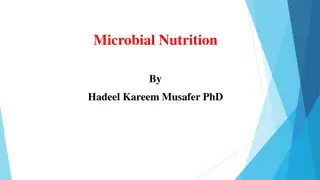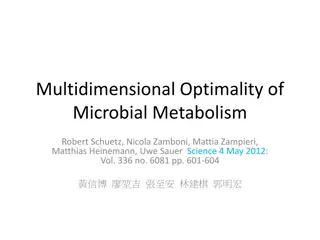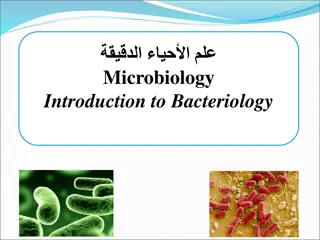Microbial Growth and Bacterial Behavior
Bacteria, an integral part of our ecosystem, exhibit fascinating growth patterns and survival strategies. Explore the history of bacterial cultivation, understand the concept of bacterial growth, and learn about doubling time in microbial populations. Discover how bacteria thrive in various environments, from extreme conditions to natural habitats. Delve into the world of microbiology through the lens of microbial growth and adaptation.
Download Presentation

Please find below an Image/Link to download the presentation.
The content on the website is provided AS IS for your information and personal use only. It may not be sold, licensed, or shared on other websites without obtaining consent from the author.If you encounter any issues during the download, it is possible that the publisher has removed the file from their server.
You are allowed to download the files provided on this website for personal or commercial use, subject to the condition that they are used lawfully. All files are the property of their respective owners.
The content on the website is provided AS IS for your information and personal use only. It may not be sold, licensed, or shared on other websites without obtaining consent from the author.
E N D
Presentation Transcript
MICROBIAL GROWTH CLS 311: Basic Microbiology Mrs. Amany Ahmed Niazy
HISTORY The greatest contributor to methods of cultivating bacteria was Robert Koch (1843-1910). Koch initially experimented with growing bacteria on the cut surfaces of potatoes. Then gelatin was used initially to solidify the media. But it has a 2 major drawback: It melts at the temperature preferred by many medically important organisms. Many bacteria digest it.
THE MARVELOUS BACTERIA. Bacteria can live in environment that no unprotected human could survive (e.g. ocean depths, volcanic vents ..etc). However, each species of bacteria has a limited set of environmental conditions in which it can grow; even then , it will grow only if specific nutrients are available.
What Do We Mean By Bacterial Growth? When we are talking about bacterial growth we are really referring to the number of cells, not the size of the cells. Bacteria that are growing are increasing in number, accumulating into colonies of hundred of thousands of cells, or population of billion of cells. A colony should have millions of bacterial cells to be seen by naked eye.
DOUBLING TIME (GENERATION TIME) The time taken by a bacteria to double in number. It varies greatly according to : Type of organism Temperature Nutrients Other conditions. 10 cells of a food-borne pathogen in a potato salad, sitting for 4 hours in the warm sun at a picnic, may multiply to more than 40,000 cells. N1= N0X 2n N1 N0 n number of bacterial cells at a given time. original number of cells in a population. number of divisions those cells have undergone during that time.
PROBLEM E.coli have a generation time of 20 minutes. If you start with 1 E.coli cell how many do you have after 2 hours. N1= N0X 2n. 64 = 1 x 26 120 minutes / 20 minutes = 6 If it is 2 hours then 6 generations
BACTERIAL GROWTH IN NATURE Bacterial growth and behavior in natural environment differ than its growth and behavior in the laboratory. E.g. when prokaryotes grow in a running stream, it frequently synthesize slime layers or other structures that allow them to attach to rocks.
BACTERIAL GROWTH IN NATURE BIOFILMS Biofilms: are communities of bacteria that attach to surfaces and live in polysaccharide-encased communities. The Dutch scientist Anton van Leeuwenhoek first noticed biofilms back in 1683. When placing a scraping of plaque from his own teeth under one of his first-generation microscopes, he spotted a host of very little living animalcules, very prettily a- moving. For most of the next 300 years, however, biofilms were largely ignored, as microbiology focused on individual organisms in their free- floating, or planktonic, state.
BIOFILMS 65% of human bacterial infections involve biofilms.
INTERACTION OF MIXED MICROBIAL COMMUNITIES Prokaryotes in the environment grow in close associations with many different species. Following are some examples: 1. bacteria that cannot grow in presence of O2can grow in the mouth because some bacteria in the mouth consume O2during their metabolism creaing a microenvironments that lack O2. 1. Some metabolic wastes of one species of bacteria may serve as a nutrient for another. 1. Some bacteria can synthesize toxic compounds that inhibit other bacterial competitors. 1. Diifrent bacterial species in such communities usually compete for hytrients.
OBTAINING A PURE CULTURE IN THE LAB Only an estimated 1% of all bacteria can currently be cultivated successfully. Fortunately most of the known medically significant bacteria can be grown in pure culture. Understandably the associations of the bacteria in a natural environment cannot be reproduced in the lab.
OBTAINING A PURE CULTURE IN THE LAB To obtain a pure culture we need: The the glassware, media, and instruments to be sterile before using it. We should work using aseptic techniques.
OBTAINING A PURE CULTURE IN THE LAB Colony when supplied with the right nutrients and conditions a single bacterium will multiply on a solid medium in a limited area to form a colony. Around 1 million cells are required for a colony to be visible to the naked eye. Agar polysaccharide extracted from marine algae. 95 C or above liquid 45 C solidify.
BACTERIAL GROWTH IN LABORATORY In the laboratory, bacteria are typically grown in broth contained in a tube or on an agar plate. These are considered closed systems because nutrients are not renewed, nor are waste products removed.
BACTERIAL GROWTH CURVE In any closed system the cell population increases in number in a predictable fashion and then eventually declines. Bacteria in a closed system fallow a pattern of stages that is called growth curve. This growth pattern is most distinct in a broth culture rather than a plate culture.
5 PHASES IN A BACTERIAL GROWTH CURVE 1. Lag Phase: where the bacteria absorb nutrients, synthesize enzymes, and prepare for division. There is no increase in bacterial number in this phase. During this time they synthesize macromolecules required for multiplication, including enzymes, ribosomes, and nucleic acids, and they generate energy in the form of ATP. If cells are transferred from a nutrient-rich medium to one containing fewer nutrients, the lag time tends to be longer.
5 PHASES IN A BACTERIAL GROWTH CURVE 2. Log Phase (logarithmic growth phase): where rapid multiplication occur causing very high increase in the number of bacteria. The cells divide at a constant rate and their numbers increase by the same percentage during each time interval. Doubling time (generation time) is measured during this period. At this stage bacteria are most susceptible to antibiotics and other chemicals. At this stage bacteria also produce metabolites that are commercially valuable (e.g. flavoring agents, food supplements antibiotics)
5 PHASES IN A BACTERIAL GROWTH CURVE 3. Stationary Phase: where the nutrients in the media decrease and the toxic waste resulting from bacterial metabolism increase. As a result, the multiplication is slowing down. The number of dividing bacteria equals the number of dead bacteria. Length of time cells remain in this stage varies depending onthe species and on environmental conditions.
5 PHASES IN A BACTERIAL GROWTH CURVE 4. Death Phase: where overcrowding occurs and the bacteria are dying very rapidly because of lack of nutrients and accumulation of toxic waste. Very few bacteria will remain alive in this stage. Once bout 99% of the cells have died off, the remaining members of the population enter a different phase.
5 PHASES IN A BACTERIAL GROWTH CURVE 5. Phase decrease in the number of viable cells in the population, lasting for days to years. of Prolonged Decline very gradual Many members of the population are dying and releasing their nutrients, while a few fitter cells more able to cope with the deteriorating environmental conditions are multiplying. This dynamic process generates successive waves of slightly modified populations, each more fit to survive than the pervious ones.
Phase of Prolonged decline
FACTORS AFFECTING MICROBIAL GROWTH There are some factors that affect and control the growth of microorganisms around us, in hospitals, in the laboratory, and in industrial settings. These factors are: 1. 2. 3. 4. 5. 6. 7. Availability of Nutrients Moisture Temperature pH Osmotic pressure Atmospheric Pressure Gaseous Atmosphere
1. AVAILABILITY OF NUTRIENTS Nutrients are crucial for microorganisms to survive in the environment. Type of nutrient needed vary based on type of microorganism. Bacteria should synthesize its cell components from these nutrients.
Chemical Function Carbon, oxygen, and hydrogen Components of cellular constituents including amino acids, lipids, nucleic acids, and sugars. Component of amino acids and nucleicacids. Nitrogen Sulfur Component of some amino acids Phosphorus Component of nucleic acids, membrane lipids, and ATP Pottassium, magnesium, and calcium Required for the functioning of certain enzymes; additional functions as well. Iron Part of certain enzymes.
1. AVAILABILITY OF NUTRIENTS Prokaryotes in general have a remarkable ability to use diverse sources of these elements. For example, prokaryotes are the only organisms able to use atmospheric nitrogen as a nitrogen source.
2. MOISTURE All organisms on planet need water for their metabolic processes and most will die if moisture is too little. Some bacteria and parasites can stay dormant in endosporesand cysts until moisture is available for their growth. Dissolved substances such as salt & sugars interact with water molecules and make the water unavailable to the cell.
3. OSMOTIC PRESSURE Prokaryotes that can grow in high solute solutions maintain the availability of water in the cell by increasing their internal solute concentrations. Halotolerant organisms: Are organisms that can grow in relatively high salt solutions, up to approximately 10% NaCl Halophilic organisms (salt lovers): Are organisms that require high levels of sodium chloride. e.g. microorganisms living in the Dead Sea.
3. OSMOTIC PRESSURE Isotonic solutions: solutions where the concentration of the solute is equal to that of normal cells found in it; thus no osmotic pressure is exerted. Most organisms prefer isotonic solutions. Hypotonic solutions: Solutions where solute concentration outside the cell is less than that inside the cell. Thiscause microbial cells to swell then burst (die). Hypertonic solutions: Solutions where solute concentration outside the cell is more than that inside the cell. This cause microbial cells to shrink (inhibiting growth).
4. ATMOSPHERIC PRESSURE Most bacteria live at normal atmospheric pressure (14.7 psi ) and are not affected by minor changes in it. Barophiles: Organisms that like very high atmospheric pressure e.g. organisms living in oil wells and deep oceans.
5. TEMPERATURE Microorganisms have optimum temperature required for their growth, this temperature depends on their enzymes. Each species of microorganism has a well-defined upper and lower temperature limit within which it grows. Within this range lies the optimum growth temperature (the temperature at which the organism multiplies most rapidly.)
5. TEMPERATURE Microorganisms can be classified according to their preferred temp. into: 1 Thermophiles (heat lover): Microorganisms that grow best at high temp. 45-80 C e.g. organisms living in hot springs, archaea. 2 Microorganisms that grow best at moderate temp. 15-40 C e.g. Normal Flora, most disease-causing bacteria. Mesophiles: 3 Microorganisms that grow best at low temp. -5 and 15 C e.gBread Mold. Psychrophiles (cold lover):
5.TEMPERATURE & FOOD STORAGE Refrigeration temperatures retards food spoilage because it limits the growth of otherwise fast- growing mesophiles. However psychrophiles can grow and multiply and consequently spoilage will still occur. Long term storage freezing is better. Freezing is NOT an effective mean to destroy microbes.
6. PH Most microorganisms prefer a neutral or slightly alkaline growth medium pH 7-7.4. Some microorganisms like acidic or alkaline environments: 1. Acidophiles: microorganisms that grow best in acidic media pH 2-5 e.g. Fungi& Helicobacter pylori. Alkaliphiles: microorganisms that grow best in alkaline media pH 8.5-11 e.g. Vibrio cholera (the only alkaliphilic human pathogen). Neutrophiles: bacteria that can live an multiply within the range of pH5 -8. most bacteria are neutrophiles. 2. 3.
6.PH Despite the pH of the external environment, cells maintain a constant internal pH, typically near neutral .
7. GASEOUS ATMOSPHERE Microorganisms can be classified according to their requirement for oxygen
GASEOUS ATMOSPHERE Obligate Aerobes require 20-22% O2. get energy by aerobic respiration will die in the presence of O2. get energy by anaerobic respiration or fermentation Grow better if O2is present, but can grow without it. require 5% only of O2higher concentrations will inhibit their growth. Indifferent to O2 Obligate Anaerobes Facultative Anaerobes Microaerophiles Aerotolerant
7. GASEOUS ATMOSPHERE O2 can be converted into a number of compounds that are highly toxic such as: Superoxide O2- Hydrogen peroxide H2O2 To survive this the bacteria must have enzymes that can convert these toxic derivatives to non-toxic forms, these enzymes include: Superoxide dismutase catalase
BACTERIAL GROWTH IN VITRO In order for bacteria to grow in the laboratory it need appropriate growth medium and special environmental conditions like temperature, pH, O2,.. to multiply. Bacteria can be cultured on many different culture media according to its nutritional needs such as Nutrient Agar, Blood Agar, Mac Conkey Agar, CLED,.. After inoculation of media, they should be incubated in chambers to maintain appropriate environment. Temperature and time of incubation differ for each type of bacteria to grow.
GENERAL CATEGORIES OF CULTURE MEDIA Chemically Defined Media: Composed of precise amounts of pure chemicals. Usually used in research to study the nutritional requirements of bacteria. Complex Media: Contains a variety of ingredients such as meat juices and digested proteins. Many ingredients can be added to this media according to our need.
GENERAL CATEGORIES OF CULTURE MEDIA Selective Media: Inhibit the growth of organisms other than the one being studied. Differential Media: Contain a substance that certain bacteria change in a recognizable way.
BACTERIAL COUNT Microbiologists tend to measure the number of bacteria present in a liquid for quality control purposes in FDA (Food and Drug Administration) monitored fields e.g. dairy farms, drinking water supply, drug industry...
METHODS OF MEASURING BACTERIAL GROWTH Direct Cell Count: used to determine total number of cells, it count both dead and living cells Direct microscopic count: Done using counting chamber. cheap and rapid but at least 107cells /ml must be present to be effective. Cell-counting instrument: Use machines such as coulter counters and flow-cytometers. Both count cells in a suspension as they pass as single line through small tube.
